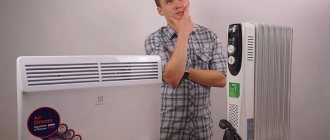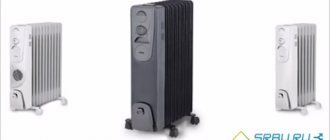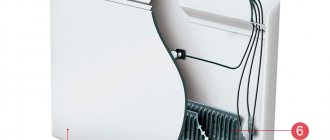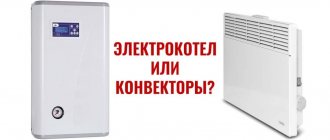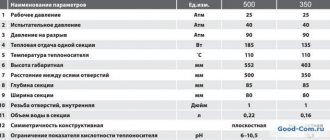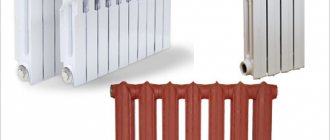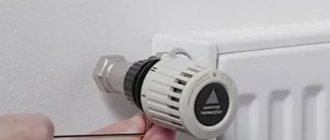The purpose of installing heating devices is to heat the room. Stores offer batteries, convectors, fan heaters and much more. Of course, every manufacturer praises its equipment and claims that its products are the highest quality. Let's do a little research and find out which is better - a convector or a radiator.
What distinguishes a convector from a radiator
The described devices are a type of heating devices. They can work independently or as elements of a heating system. The main difference between a convector and a radiator is the design and operating principle of the devices.
Radiator
It is a unit with a sectional metal body. All free space in the sections is filled with coolant. Water, special mineral oil or antifreeze liquid are used as a coolant.
The operating principle of the unit is based on the thermal radiation method. Under the influence of a heat source, the coolant is heated. This source is the heating element.
An increase in coolant temperature leads to heating of the surface of the device body. The heated body releases heat into the surrounding space. Under the influence of thermal radiation, the heating level in the room increases.
The coolant temperature is monitored by a built-in thermal sensor. Automation turns the device on and off when the set values are reached. The heating of the working fluid is controlled using a built-in thermostat.
Convector
To answer how a heating convector differs from a radiator, let’s consider the operating principle of the device.
The operation of the device is based on the convection of air masses in the room. It is an installation with a panel-type metal casing. The housing contains a heating element with a thermostat. The thermostat is used to regulate the heating temperature.
The housing has an open space at the bottom. Through it, a flow of cold air enters the housing. The heating element heats the cold air to a predetermined level. Heated air currents rush upward.
To accelerate and direct the warm air flow, special blinds are used in the device body.
Warm air masses displace cold air in the upper part of the room. The flow of cold air falls down. Below it again enters the device body. The working cycle of air movement is repeated.
The set temperature level in the room is controlled by a thermal sensor. Triggering of the sensor leads to automatic switching on and off of the device. Adjustment of the specified parameters is carried out using a mechanical or electronic control unit.
Operating principle
Installed in a heating system, a radiator or convector receives thermal energy from the circulation of coolant through the pipeline. The key difference is in the ways of return:
- Radiators increase air temperature through thermal radiation. The steel, aluminum, cast iron surface comes into contact with the air mass and gives off heat, which is partially distributed throughout the space.
- The convector device accelerates air circulation and heat distribution. Heated air rises, cold air falls to the heat exchanger.
Pros and cons of water convectors
Convection technologies are progressive and have high efficiency. Pros of heating devices:
- heating rate;
- thermal curtain effect when installed under a window;
- configurations: wall, floor, ceiling, built-in, baseboard;
- mobility, ergonomics - non-built-in models weigh 10-20 kg;
- uniform heat distribution;
- protection of the user from contact with coolant;
- comfort - does not dry out the air.
Convectors are inferior to radiators in terms of thermal power and service life. The equipment is demanding in terms of operating conditions - installation in systems with contaminated coolant is unacceptable, water hammers are fraught with accidents. Drafts reduce the efficiency of conventional heat exchange.
Intense air circulation during operation of the device raises dust and particles, which is dangerous for allergy sufferers and people with respiratory diseases.
Radiator characteristics
The operating principle of radiators is less efficient due to local heating, but the devices are universal and unpretentious to operating conditions. Advantages of the devices:
- hygiene, absence of dust from the operation of the equipment;
- long service life;
- tolerance to coolant quality;
- resistance to pressure, water hammer;
- Installation in limited space, embedding into walls or furniture is allowed.
Disadvantages of heating devices are dimensions, weight, low heating rate, and uniform design.
Advantages and disadvantages of convectors
The answer to the question of which is better, a convector or a radiator, allows us to obtain an analysis of the advantages and disadvantages of both types of systems.
The advantages of the devices include:
- Autonomous operation mode.
- Low level of heating of the housing surface (up to +70 ᵒC).
- Quick heating of cold air (1-1.5 minutes).
- Lack of coolant and pipelines.
- Possibility of combining devices into one network.
- Convenient control of one or several devices simultaneously.
- Simplicity of design and installation of the installation.
- Quiet and environmentally friendly.
- Explosion and fire safety.
- Modern design.
The disadvantages are:
- Large amount of electricity used.
- High cost of multifunctional installations.
- Low level of electrical safety.
Advantages and disadvantages of radiators
The advantages of these devices include:
- Ease of Management.
- Ease of movement.
- Affordable price.
- Easy to care and maintain.
The disadvantages are:
- High level of heating of the housing surface (up to +100 ᵒС…+120 ᵒС).
- High fire hazard.
- Heavy weight.
The listed pros and cons will help buyers determine what is better to use in the apartment - a convector or a radiator.
Warmth is the main joy in cold weather
Radiators - accumulate thermal energy received from the coolant, and then release it into the surrounding air.
You should approach this issue carefully: familiarize yourself with all possible market offers, choose the optimal price-quality ratio
It is necessary to take into account the layout and purpose of the room, the time people spend in the room with the heating device, as well as the location of the heater installation
To make the task easier, we will introduce you to the most popular and inexpensive heating options, namely convectors and radiators. The devices have stood the test of time and rightfully occupy a leading position among heaters. Let's consider the general characteristics of these heating devices, the principle of operation, as well as the pros and cons of each option. Let's try to determine what is better, more profitable and more reliable. Before we start choosing a heating device, let’s figure out how a radiator differs from a convector.
Technical characteristics and cost of heaters
The main characteristics and cost of heating radiators and convectors are given in the table.
| Model name | Specifications | Manufacturer country | Cost, rub. |
| Radiators | |||
| Ballu BOH/CL-05WRN 1000 | Number of modes – 3. Number of sections – 5. Power, kW – 1.0. Heating area, m2 – 15. Control – mechanical. Thermostat - yes. Weight, kg – 4.2. | Russia | 1 990 |
| Vitek VT-1709 W | Number of modes – 3. Number of sections – 9. Power, kW – 2.0. Heating area, m2 – 20. Control – mechanical. Thermostat - yes. Weight, kg – 6.5. Functions: * shutdown when overturning; * overheat protection. | China | 3 990 |
| De Longhi TRRS0920C | Number of modes – 3. Number of sections – 9. Power, kW – 2.0. Heating area, m2 – up to 24. Control – mechanical. Thermostat - yes. Weight, kg – 12. Functions: * frost protection. | China | 8 990 |
| Convectors | |||
| Ballu BEC/EM-1000 | Number of modes – 2. Power, kW – 1.0. Heating area, m2 – up to 15. Control – mechanical. Thermostat - yes. Weight, kg – 3.0. Functions: * shutdown when overturning; * overheat protection. | Russia | 1 990 |
| Electrolux ECH/B-1500 E | Number of modes – 5. Power, kW – 1.5. Heating area, m2 – up to 20. Control – electronic. Thermostat - yes. Weight, kg – 3.0. Functions: * shutdown when overheating; * frost protection. | China | 5 790 |
| Bork R704 | Number of modes – 3. Power, kW – 1.0. Heating area, m2 – up to 20. Control – electronic. Thermostat - yes. Weight, kg – 5.6. Functions: * touch screen; * automatic maintaining heat; * shutdown when overturning; * protection from children; * overheat protection; * remote control. | China | 12 890 |
Comparison of tabular data shows a slight increase in the cost of convectors. This is due to the increasing degree of automation and the presence of a large number of useful functions.
The final assessment of whether convectors or heating radiators is better will be made by comparing the operating and maintenance features of the devices.
How to make the right choice
The numerous radiators and convectors currently on the market are varied, so choosing just one device will not be so easy. It must be remembered that each device, regardless of its type, has its own advantages, and in many situations they are able to operate at almost equal power. Keep in mind that any radiator of correctly selected power will warm the room, but a convector is much safer and does not cause any inconvenience - this is the main difference between the devices.
When it comes to what is better - a convector or a radiator, many mention the extremely low cost of the second option, which also significantly increases the demand for it. Despite this, innovative and modern convectors are becoming more and more popular every year, as manufacturers produce additional modifications of such devices. Now they can be installed in any room, built into the floor (in-floor models), mounted on the wall (wall-mounted) or placed on the floor (floor-mounted) in a convenient and most suitable place. To make the right choice, you need to take into account the features of a particular room, its area, decoration, size and design. You can choose either a radiator or an electric convector of any type.
Features of operation of radiators and convectors
Each of the types of installations under consideration has individual characteristics. Comfortable operation of devices is determined by the number of useful functions.
Radiators
These heaters provide quick heating of rooms. The automatic regulator ensures stable temperature in the room. The coolants used have high thermal conductivity.
For ease of movement, many devices are equipped with wheels. Transfer to another location using the built-in handle. To protect against tipping, side stops are used. A wall-mounted heated towel rail is used to dry small items. On the end side of the control unit there is space for the power cable.
Convectors
The devices have a convenient control system. The main element of this system is a mechanical or electronic thermostat.
The mechanical thermostat is easy to use. Manually operated units have low cost. The main disadvantages are noisy operation and low accuracy of temperature setting. The adjustment step of the mechanical thermostat does not exceed 5 ᵒC.
An electronic thermostat allows you to set the temperature with an accuracy of 0.1 ᵒC. Such devices have several operating modes. It is possible to change settings and program operating modes. Quiet operation allows the use of electrical appliances in bedrooms.
A large number of useful functions in the question of what is better for an apartment - a convector or a radiator - make the difference in favor of devices of the first type. These devices have the following convenient features:
- frost protection;
- Keypad lock;
- economy mode;
- remote control;
- Internet connection.
The “Freeze Protection” function allows you to autonomously maintain the indoor temperature at a level of +5 ᵒС…+7 ᵒС. Used in country houses and in houses without central heating.
Safety first
The types of devices being compared are classified as high-risk heating devices. The devices are equipped with built-in overheating protection. When the maximum temperature is reached, the device automatically turns off.
Electrical devices have an increased risk of electric shock. To prevent injury, it is necessary to strictly comply with fire and electrical safety requirements.
Some models are used in rooms with high humidity. To protect against damage, the devices have a high degree of sealing.
